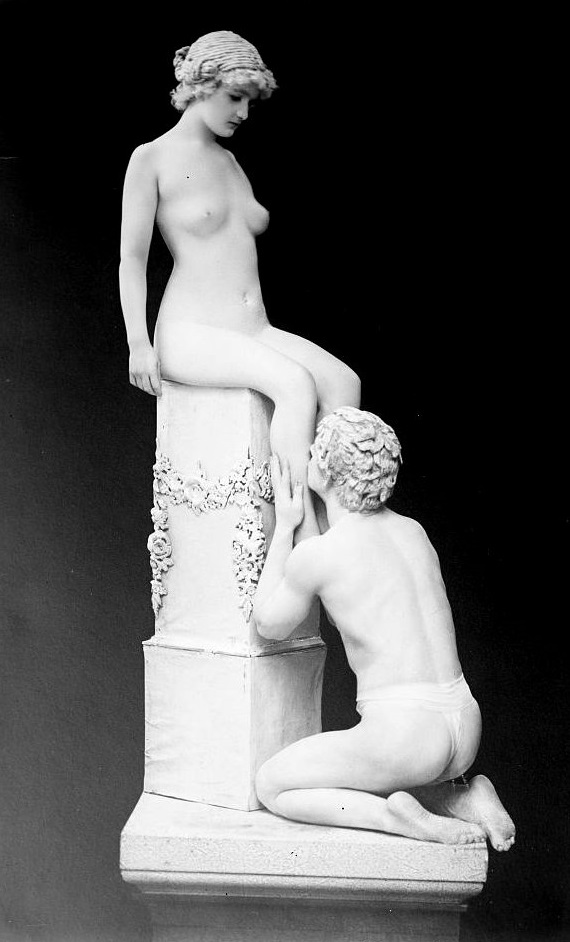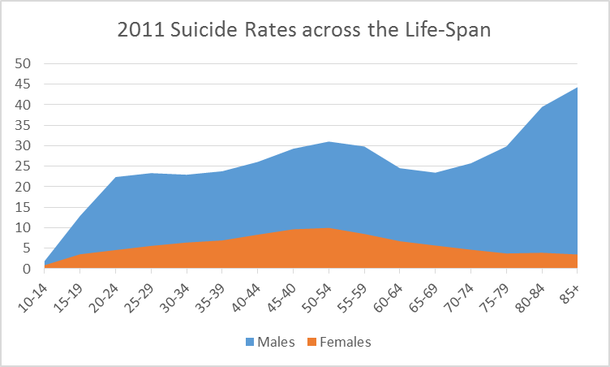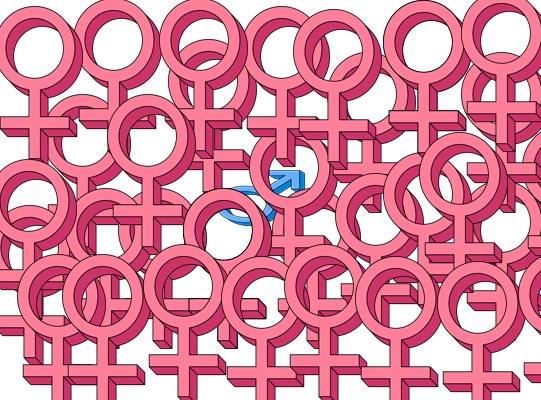The following article is the second of a two-part series. Part one looked at the roots of damseling, chivalry and courtly love in the gynocentric tradition. In part two we look at damseling, chivalry and courtly love as it appears in the feminist tradition. – PW
_________________
FEMINISM
Before being given the name feminism, the obsession with women’s status was referred to as the Querelle des Femmes or quarrel about women. The querelle consisted of a perpetual social movement that used damseling to call for more chivalry and more courtly love, which ultimately afforded women more power.
The three elements of gynocentrism first born in medieval Europe – damseling, chivalry and courtly love – continue to act as the basis of modern feminism. Indeed feminism today is little more, and little less, than a perpetuation of this medieval triad, giving feminism its internal drive even as feminists disavow these essentials with rhetorical obfuscations.
With this charge in mind let’s revisit the holy trinity above with a focus on behaviors central to modern feminism.
Damseling as “victim feminism”
Most observers today, including feminist observers like Christina Hoff-Sommers, Camille Paglia, Rene Denfeld, Katie Roiphe and others agree that feminism comes close, if not all the way, to being a cult of victimhood.
The phenomenon has variously been referred to as grievance feminism, victim feminism, safe space feminism, and even fainting-couch feminism – with Christina Hoff-Sommers portraying its mythos as “a battle between fragile maidens and evil predators.” 1
Feminist icon Naomi Wolf tells that victim feminism evolved out of “old habits of ladylike behavior that were cloaked in the guise of radicalism,” 2 and laments that a substantial segment of modern feminism is devoted to its cause.
Denfeld writes that current feminists “promote a new status for women: that of the victim,” and adds:
“This is victim mythology. From rape redefinitions to feminist theory on the “patriarchy,” victimization has become the subtext of the movement, the moral to be found in every feminist story. Together these stories form a feminist mythology in which a singular female subject is created: woman as a helpless, violated, and oppressed victim. Victim mythology says that men will always be predators and women will always be their prey. It is a small place to live, a place that tells women that there is really no way out.
“Like other mythologies, victim mythology reduces the complexity of human interaction to grossly oversimplified mythical tales, a one-note song, where the message of the story becomes so important that fiction not only triumphs over fact but the realities of women’s experiences are dismissed and derided when they conflict with the accepted female image.3
While Denfeld does a good job of describing feminism’s victim mentality, she labors under a myth of her own by characterizing it as a “new” fetish among feminists. Anyone reading through the history of feminist literature can see it appealed to by literally every feminist writer. Even a century ago Ernest Belfort Bax was able to say that feminists “do their best to bluff their dupes by posing as the victims of a non-existent male oppression.”4
Feminists well know that the most grotesquely far-fetched cry about the injustice of man to woman will meet with a ready ear. They well know that they get here fond and foolish man on his soft side. Looking at the matter impartially, it is quite evident that man’s treatment of woman is the least vulnerable point in his moral record. Woman, as such, he has always treated with comparative generosity. But it is, of course, to the interests of the abettors of female domination to pretend the contrary. Accordingly everything has been done to excite prejudice in favour of woman as the innocent and guileless victim of man’s tyranny, and the maudlin Feminist sentiment of the “brute” man has been carefully exploited to this end.5
In all of these accounts the behavior being described is damseling, a practice feminists have been at the forefront of preserving from the medieval canon. Evoked in conjunction with claims of male brutality, rapiness, depravity and insensitivity, the ultimate purpose of damseling is to draw chivalric responses from men, a routine Wolf makes clear in her remark that “victim feminism casts women as sexually pure and mystically nurturing, and stresses the evil done to these ‘good’ women as a way to petition for their rights.” 6
A famous example of feminist damseling, both literal and figurative, is Anita Sarkeesian. Sarkeesian is known for raising concerns that video-games are misogynistic – like most everything else found in the feminist worldview. Her primary concern was that female game characters are often portrayed as damsels-in-distress saved by male heroes, which promotes, she says, sexual objectification and a range of other problems. To address that issue in video games she moved to launch a study project to raise awareness.
Sarkeesian established a fundraiser for $6,000.00 for her project, but after receiving some initial trolling by trolls on social media she damseled herself to potential donors by saying she was under grave threat, swooning with such finesse that she was showered with 158K in donations from fellow feminists and white knights. Over a thousand people donated after hearing of her “plight.”
With that financial success, Sarkeesian subsequently replayed the scenario over and again particularly in the context of further fundraising efforts and public speaking; swooning about online attacks directed against her or over female gamers enduring abject sexism, female video-game characters being cast in degrading and/or humiliating roles, and about young impressionable girls being robbed of agency after being subjected to the damsel trope in games.
Sarkeesian’s case is particularly poignant because, from the many subjects she could have highlighted to damsel herself for attention, she chose to damsel herself over the very existence of damsels. This demonstrates that even when disavowing the medieval pageant of damsels in distress, feminists continue to enact it even while obfuscating their complicity in the tradition.
Feminism would have died out long ago if it were not for the power of this ancient ruse, and while damseling continues to draw rewards from a public primed to cater to it, the planet will increasingly come to resemble a tower full of imprisoned, vulnerable Disney Princesses.
Chivalry – from husband Sam to Uncle Sam
Equity feminist Christina Hoff-Sommers states that men need to be civilized with chivalric manners, a belief outlined in an interview with Emily Esfahani Smith, where she said, “Chivalry is grounded in a fundamental reality that defines the relationship between the sexes,” and adding a warning, “If women give up on chivalry, it will be gone.” 7
While feminists like Hoff-Sommers admit their reliance on a sexist version of chivalry, others are less candid about it, going even so far as pretending they don’t need chivalry despite their demonstrable appeal to it in most of their activism. Many observers however can see through the anti-chivalry posturing.
Feminism draws its power from chivalric support, but instead of soliciting it from men in the traditional, interpersonal manner it has learned how to get it solely from the government – holding the government to ransom ever since the suffragettes damsaled the vote for women. Since that time politicians have only been too willing to furnish demands by feminists in exchange for voting the candidate into power and allowing him to retain office – and conversely politicians who fail to uphold the chivalric contract are promptly voted out.
The results of this compact are obvious to anyone who looks at political decisions with impartiality.
Instead of men giving up seats in buses, government now provides seats in legislative assemblies and boardrooms via quotas. Instead of men opening car doors for women, government opens doors into universities and workforces via affirmative action. Instead of men being the sole protectors of women from violence, government now protects them with an army of police specially trained to service women’s accusations (over and above more serious crimes). Instead of men providing living expenses, governments now provide it as social welfare and compensation for the wage-gap. Government as substitute husband.
The appeal to chivalry is not confined to government institutions alone. The appeal also goes out to sporting clubs, business owners, CEOs and private institutions who respond to the damsel’s call with women-only busses, women-only safe spaces, pink car parking spaces with extra lighting and security with male escorts and chaperones, or with feminist adverts at sports venues, sportsmen wearing pink to raise money for all manner of feminist projects, and that on top of monies already heaped at their feet by politicians eager to please.
This is not a recent development; it can be witnessed in mirror image as far back as a century ago. Back then, Bax was able to tie feminism so definitively with the act of chivalry-seeking that he actually labeled the women’s liberation movement “chivalry feminism.” Moreover, Bax saw through the superficial disavowals;
“The justification for the whole movement of Modern Feminism in one of its main practical aspects – namely, the placing of the female sex in the position of privilege, advantage and immunity – is concentrated in the current conception of “chivalry.”
It is plain then that chivalry as understood in the present day really spells sex privilege and sex favouritism pure and simple, and that any attempts to define the term on a larger basis, or to give it a colourable rationality founded on fact, are simply subterfuges, conscious or unconscious, on the part of those who put them forward…
Such is “chivalry” as understood to-day – the deprivation, the robbery from men of the most elementary personal rights in order to endow women with privileges at the expense of men.8
Chivalry feminism today, same as it ever was, relying on men’s generosity to perpetuate its creed of power.
Courtly love as ‘Respectful Relationships’
The phrase ‘Respectful Relationships’ is shorthand for a range of conventions promoted by feminists to govern interactions between men and women, particularly in the context of romantic interactions. The conventions detail acceptable speech and actions in the contexts of socializing, friendship, flirting and sex, emphasizing a man’s duty to respect women’s emotional comfort, self-esteem, and dignity.
Portrayed overtly as a method of reducing men’s abusiveness, the program maintains that even men and boys who do not display abusive behaviors should be enculturated in its protocols as a prophylactic, and concomitantly to afford dignity and self-esteem to women. This is where the respectful relationships program moves past the overt goal of reducing violence and into the covert goal of maintaining and increasing the power of women.
As we begin to look at the detail of Respectful Relationship we could almost mistake it for Andreas Capellanus’ work The Art of Courtly Love where the medieval rules of romance were codified in meticulous prescriptions for male deference, homage, and courtesy toward women. Considering this parallel, the feminist movement appears to have provided a new language for a very old set of sexual customs, essentially reiterating that which has been with us all along.
As mentioned in Part one, central to the art of courtly love was the expectation that men practice love service toward women based on a model of vassals or serfs in relation to a feudal lord. That relationship model of serf-to-Lord was adopted wholesale to regulate love relationships whereby women were literally approached as the lord (midons) in each male-female encounter. As Medievalist Sandra Alfonsi explains;
Scholars soon saw striking parallels between feudalistic practices and certain tenets of Courtly Love. The comparisons lie in certain resemblances shared by vassalage and the courtly “love service.” Fundamental to both was the concept of obedience. As a vassal, the liegeman swore obedience to his lord. As a courtly lover, the poet chose a lady to whom he was required to swear obedience. Humility and obedience were two concepts familiar to medieval man, active components of his Weltanschauung…
The entire concept of love-service was patterned after the vassal’s oath to serve his lord with loyalty, tenacity, and courage. These same virtues were demanded of the poet. Like the liegeman vis-a-vis his sovereign, the poet approached his lady with fear and respect. Submitted to her, obedient to her will, he awaited a fief or honor as did the vassal. His compensation took many forms: the pleasure of his lady’s company in her chamber or in the garden; an avowal of her love; a secret meeting; a kiss or even le surplus, complete unity. Like the lord, the woman who was venerated and served was expected to reward her faithful and humble servant.9
The idea behind love service was that men should demonstrate the quality of their commitment to women; was it merely lust or obedient and sacrificial love? If the woman decided it was “love” then she might decide to engage more intimately with him, as Joseph Campbell explains:
“The woman is looking for authenticity in a relationship, so she delays merci until she is guaranteed that this man who is proposing himself to her is one of a gentle heart… And, the women were in control, that’s all there is to it. The man is the one who is advancing, the one performing the acts of guarding bridges, or whatever bit of foolishness she puts on him, but, she’s in control. And her problem is to live in a relationship that is authentic of love, and the only way she can do it is by testing the one who offers himself. She isn’t offering herself, he’s offering himself. But, she’s in control of what happens then with step two.10
“The technical term for a woman’s granting of herself was merci; the woman grants her merci. Now, that might consist in her permission for the man to kiss her on the back of the neck once every Whitsuntide, you know, something like that – or it may be a full giving in love. That would depend upon her estimation of the character of the candidate. The essential idea was to test this man to make sure that he would suffer things for love, and that this was not just lust.
The tests that were given then by women involved, for example, sending a chap out to guard a bridge. The traffic in the Middle Ages was somewhat encumbered by these youths guarding bridges. But also the tests included going into battle. A woman who was too ruthless in asking her lover to risk a real death before she would acquiesce in anything was considered sauvage or “savage”. Also, the woman who gave herself without the testing was “savage”. There was a very nice psychological estimation game going on here.11
Today that psychological estimation game (as Campbell puts it) might involve asking consent to sit with a woman, appealing politely for a date, waiting patiently for her to call or sweep right, keeping his knees together to avoid manspreading, or asking for permission to speak in order to prove he is not talking over her or mansplaining. Such demonstrations show the feminist woman that he has a gentle heart, and that he is willing to suffer things for love.
That psychological testing also encompasses public activities which demonstrate a man’s commitment to serving womankind as a whole. Examples would be a man walking a mile in her shoes, or joining White Ribbon Campaigns that require men, as was required of the medieval knights, to pledge oaths to “Never to condone, or remain silent about violence towards women and girls” and especially to intervene when learning of any male behaving offensively toward a woman.
Today’s White Ribbon “oath” bears a striking resemblance to the 14th century enterprise of the Green Shield with the White Lady (Emprise de l’Escu vert à la Dame Blanche) in which men committed themselves for the duration of five years to serving women. Inspired by the ideal of courtly love, the stated purpose of the order was to guard and defend the honor, estate, goods, reputation, fame and praise of all ladies. It was an undertaking that earned the praise of protofeminist Christine de Pizan. The continuity of chivalry and courtly love from the medieval knightly oath to the modern feminist-inspired oath is remarkable in its consistency.
In line with most women who expect men to follow medieval rules of love concerning male courtesy, the feminist movement is geared toward enforcing the same goal. Feminism however postures itself as disavowing that goal even while they are at the forefront of institutionalizing it in our families, our schools, our political structures and laws.
Each of the psychological tests mentioned above are evidence of a love service called for by feminist activists. Or worded differently, they are sanctified methods by which men are called to demonstrate obedience and a ‘gentle heart’ in contrast to the brutality, rapiness and exploitativeness of the savage heart; the default feminist conception of men.
I will close here with the words of an academic feminist, one not so coy about identifying courtly love with the project of feminism. Elizabeth Reid Boyd of the School of Psychology and Social Science at Edith Cowan University, and Director of the Centre for Research for Women in Western Australia with more than a decade as a feminist researcher and teacher of women’s studies tells:
In this article I muse upon arguments that romance is a form of feminism. Going back to its history in the Middle Ages and its invention by noblewomen who created the notion of courtly love, examining its contemporary popular explosion and the concurrent rise of popular romance studies in the academy that has emerged in the wake of women’s studies, and positing an empowering female future for the genre, I propose that reading and writing romantic fiction is not only personal escapism, but also political activism.
Romance has a feminist past that belies its ostensible frivolity. Romance, as most true romantics know, began in medieval times. The word originally referred to the language romanz, linked to the French, Italian and Spanish languages in which love stories, songs and ballads were written. Stories, poems and songs written in this language were called romances to separate them from more serious literature – a distinction we still have today. Romances were popular and fashionable. Love songs and stories, like those of Lancelot and Guinevere, Tristan and Isolde, were soon on the lips of troubadours and minstrels all over Europe. Romance spread rapidly. It has been called the first form of feminism (Putnam 1970).12
Reid Boyd finishes her paper by waxing poetic about the many joys of romantic love, and of its increasing popularity in academe.
Same as it ever was, the project of modern feminism can be summarized as championing victimhood (damseling), soliciting favors from men and governments (chivalry), and promoting “respectful” relationships by men-toward-women (courtly love).
References:
[1] Christina Hoff-Sommers, How fainting couch feminism threatens freedom, American Enterprise Institute 2015
[2] Naomi Wolf, Fire With Fire: New Female Power, 1993
[3] Rene Denfeld, The New Victorians: A Young Woman’s Challenge to the Old Feminist Order, 1995
[4] Ernest B. Bax, Feminism and Female Suffrage, 1910
[5] Ernest B. Bax, Mr. Belfort Bax Replies to his Feminist Critics, 1908
[6] Naomi Wolf, Fire With Fire: New Female Power, 1993
[7] Emily Esfahani Smith, Let’s Give Chivalry Another Chance, The Atlantic, Dec 10 2012
[8] Ernest B. Bax, Chapter-5 ‘The Chivalry Fake’ in The Fraud of Feminism, 1913
[9] Sandra Alfonsi, Masculine Submission in Troubadour Lyric, 1986
[10] Joseph Campbell, Parzival, the Graal, and Grail Legends, talk at the Ojai Foundation, 1987
[11] Joseph Campbell, The Power of Myth, interview with Bill Moyers, 1988
[12] Elizabeth Reid Boyd, Romancing Feminism: From Women’s Studies to Women’s Fiction, 2014




 The origins of the lack of compassion and choice for men is
The origins of the lack of compassion and choice for men is  But gynocentrism runs much deeper than simply being about protecting the borders and doing the dangerous work. It has its tendrils into just about everything, silently and without fanfare. What happens when a woman has a flat tire? How many people have seen the help she will usually garner from men? Now think about what happens if a man has a flat tire. Does he get a similar treatment? Probably not. This is gynocentrism. When there are problems we jump to help women but expect the men to handle it themselves even in today’s atmosphere of “equality”.
But gynocentrism runs much deeper than simply being about protecting the borders and doing the dangerous work. It has its tendrils into just about everything, silently and without fanfare. What happens when a woman has a flat tire? How many people have seen the help she will usually garner from men? Now think about what happens if a man has a flat tire. Does he get a similar treatment? Probably not. This is gynocentrism. When there are problems we jump to help women but expect the men to handle it themselves even in today’s atmosphere of “equality”. Think of that attractive woman being tied to the railroad tracks. What does that do to the hearts and minds of most people? Most of us have an inborn reaction that says DO SOMETHING to help her. But what about a man tied to the tracks? Is your reaction the same or different? Yes, you likely want to see him helped but is it the same gut wrenching sensation? The plots of many movies and novels are fueled by this gynocentric scenario. We all want the woman tied to the tracks safely released even if it means the death of numerous men in the process. A woman’s needs are a call to action while a man’s needs are often just ignored. He needs to save her!
Think of that attractive woman being tied to the railroad tracks. What does that do to the hearts and minds of most people? Most of us have an inborn reaction that says DO SOMETHING to help her. But what about a man tied to the tracks? Is your reaction the same or different? Yes, you likely want to see him helped but is it the same gut wrenching sensation? The plots of many movies and novels are fueled by this gynocentric scenario. We all want the woman tied to the tracks safely released even if it means the death of numerous men in the process. A woman’s needs are a call to action while a man’s needs are often just ignored. He needs to save her! Another example of extreme gynocentrism is boot camp in the army. What is done? The recruit is taught that he is nothing. He is now not an individual, he is a part of a fighting group. His personal identity is deleted and he is taught to fight for the group, for a cause. He no longer exists. There is no compassion for his personal feelings and needs. Those are a distant second. He also has zero choice. He does what he is told. That is the extreme gynocentric model that plays out to one degree or another in our everyday life.
Another example of extreme gynocentrism is boot camp in the army. What is done? The recruit is taught that he is nothing. He is now not an individual, he is a part of a fighting group. His personal identity is deleted and he is taught to fight for the group, for a cause. He no longer exists. There is no compassion for his personal feelings and needs. Those are a distant second. He also has zero choice. He does what he is told. That is the extreme gynocentric model that plays out to one degree or another in our everyday life. One of the best examples of this is the issue of domestic violence where we have known for decades that
One of the best examples of this is the issue of domestic violence where we have known for decades that  Another example is the issue of suicide
Another example is the issue of suicide  Research is showing that psychological impact of circumcision on boys is similar to the psychological impact for girls who have undergone genital mutilation. This procedure is damaging our boys while most people think it is simple little snip. Wrong. We care about our little girls but fail in mustering enough compassion for boys to shelter them from such barbaric treatment and we give them no choice. Gynocentrism.
Research is showing that psychological impact of circumcision on boys is similar to the psychological impact for girls who have undergone genital mutilation. This procedure is damaging our boys while most people think it is simple little snip. Wrong. We care about our little girls but fail in mustering enough compassion for boys to shelter them from such barbaric treatment and we give them no choice. Gynocentrism.
 In one study about childhood rape the researchers found that
In one study about childhood rape the researchers found that 
 Our focus has been on a larger scale or macro level and it is very easy to see the imbalance in so many spheres. The point here is not that the services that have been created were not a good thing or were undeserved. Many of the services offered have been very helpful to women and girls. The point here is that it has been a very one sided ride with nearly all the services going to women and girls and the men and boys basically ignored. Men and boys have simply not gotten compassion and choice. Gynocentrism 2.0.
Our focus has been on a larger scale or macro level and it is very easy to see the imbalance in so many spheres. The point here is not that the services that have been created were not a good thing or were undeserved. Many of the services offered have been very helpful to women and girls. The point here is that it has been a very one sided ride with nearly all the services going to women and girls and the men and boys basically ignored. Men and boys have simply not gotten compassion and choice. Gynocentrism 2.0.